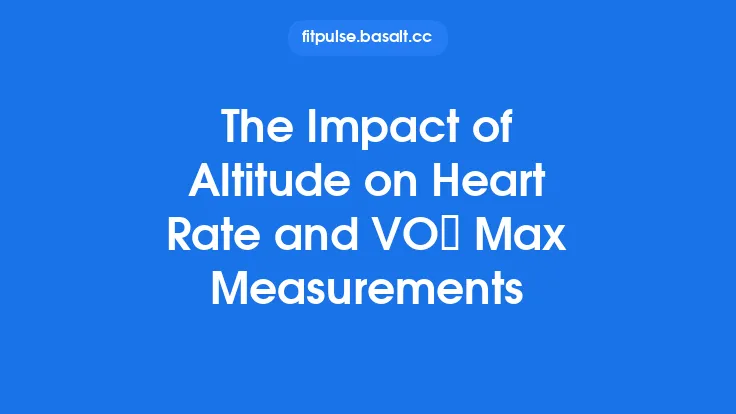Resting Metabolic Rate (RMR) is the amount of energy—expressed in calories—that the body expends while at complete physiological rest. It represents the energy required to sustain essential functions such as cellular metabolism, circulation, respiration, and thermoregulation. Because RMR accounts for roughly 60‑75 % of total daily energy expenditure (TDEE) in most individuals, accurate measurement and interpretation are indispensable tools for exercise scientists, clinicians, and fitness professionals who design nutrition and training programs.
What Is Resting Metabolic Rate and How Does It Differ From Similar Concepts?
- Resting Metabolic Rate (RMR): Measured under standardized, relaxed conditions after an overnight fast, typically in a supine or seated position. It reflects the energy cost of basic physiological processes without the influence of recent physical activity or digestion.
- Basal Metabolic Rate (BMR): Similar to RMR but obtained under stricter conditions (e.g., after 8 h of sleep, in a thermoneutral environment, and without any prior food intake or caffeine). BMR is usually 5‑10 % lower than RMR.
- Total Daily Energy Expenditure (TDEE): The sum of RMR/BMR, the thermic effect of food (TEF), and activity‑related energy expenditure (including both structured exercise and non‑exercise activity thermogenesis, NEAT).
Understanding these distinctions helps avoid misinterpretation of data and ensures that the appropriate metric is used for a given purpose.
Physiological Determinants of RMR
| Determinant | Mechanism | Typical Influence on RMR |
|---|---|---|
| Fat‑Free Mass (FFM) | Skeletal muscle, organ tissue, and bone are metabolically active. | Each kilogram of FFM contributes ~20‑25 kcal/day. |
| Age | Cellular metabolism slows, and organ mass declines with age. | RMR decreases ~1‑2 % per decade after the third decade. |
| Sex | Men generally have higher FFM and lower body fat percentages. | Men’s RMR is ~5‑10 % higher than women’s, all else equal. |
| Hormonal Status | Thyroid hormones, catecholamines, and sex hormones modulate metabolic pathways. | Hyperthyroidism can raise RMR by 20‑30 %; hypothyroidism reduces it. |
| Genetics | Polymorphisms affecting mitochondrial efficiency and uncoupling proteins. | Can account for 10‑15 % of inter‑individual variability. |
| Body Temperature & Thermoregulation | Maintaining core temperature requires heat production. | Cold exposure can increase RMR via non‑shivering thermogenesis. |
| Recent Food Intake | The thermic effect of food (TEF) raises metabolic rate for 2‑4 h post‑prandial. | RMR protocols require a ≥12 h fast to eliminate TEF influence. |
Standardized Protocols for Measuring RMR
Accurate RMR assessment hinges on controlling environmental and physiological variables. The most widely accepted method is indirect calorimetry, which quantifies oxygen consumption (VO₂) and carbon dioxide production (VCO₂) to calculate energy expenditure using the Weir equation.
1. Equipment Requirements
- Metabolic Cart: High‑precision gas analyzers (±0.1 % for O₂ and CO₂) with a calibrated flowmeter.
- Mouthpiece or Mask: Low‑resistance, airtight interface to capture expired gases.
- Calibration Gases: Known concentrations of O₂ and CO₂ for daily calibration.
- Environmental Controls: Room temperature 22‑24 °C, humidity 40‑60 %, and minimal airflow disturbances.
2. Participant Preparation
| Step | Detail |
|---|---|
| Fasting | Minimum 12 h fast; water allowed. |
| Caffeine & Nicotine | Avoid for at least 12 h. |
| Exercise | No vigorous activity for 24 h prior. |
| Sleep | Adequate sleep (≥7 h) the night before. |
| Clothing | Light, comfortable attire; remove heavy garments. |
| Acclimatization | Rest quietly for 15‑30 min in the testing environment before measurement. |
3. Testing Procedure
- Baseline Calibration: Perform zero and span calibrations using ambient air and known gas mixtures.
- Steady‑State Verification: Collect data in 1‑minute intervals; a steady state is defined as a coefficient of variation (CV) ≤10 % for VO₂ and VCO₂ over a consecutive 5‑minute window.
- Duration: Record for at least 20‑30 minutes; discard the first 5‑10 minutes to allow for stabilization.
- Data Averaging: Use the final 5‑minute steady‑state period to calculate average VO₂ and VCO₂.
- Energy Expenditure Calculation: Apply the Weir equation:
\[
\text{EE (kcal/day)} = \left(3.941 \times \text{VO}2 + 1.106 \times \text{VCO}2\right) \times 1440
\]
(where VO₂ and VCO₂ are expressed in L/min).
4. Quality Assurance
- Repeatability: Conduct at least two separate measurements on different days; the intra‑individual coefficient of variation should be ≤5 %.
- Cross‑Validation: When possible, compare indirect calorimetry results with predictive equations (e.g., Cunningham, Harris‑Benedict) to identify outliers.
Predictive Equations: When Direct Measurement Is Not Feasible
Although indirect calorimetry remains the gold standard, field practitioners often rely on equations that estimate RMR from anthropometric and demographic data. The most reliable equations incorporate fat‑free mass because it directly reflects metabolically active tissue.
| Equation | Variables | Typical Error (SEE) |
|---|---|---|
| Cunningham | RMR = 500 + 22 × FFM (kg) | ± 5 % |
| Mifflin‑St Jeor | RMR = (10 × weight kg) + (6.25 × height cm) – (5 × age) + s (s = +5 for men, –161 for women) | ± 10 % |
| Katch‑McArdle | RMR = 370 + (21.6 × FFM) | ± 5 % |
| Harris‑Benedict (Revised) | RMR = 88.362 + (13.397 × weight) + (4.799 × height) – (5.677 × age) (men) <br> RMR = 447.593 + (9.247 × weight) + (3.098 × height) – (4.330 × age) (women) | ± 10 % |
Key Takeaway: Predictive equations are useful for large‑scale screenings or when equipment is unavailable, but they should be treated as approximations. Whenever precise energy budgeting is required—such as in clinical nutrition or elite athlete programming—direct measurement is preferred.
Practical Applications of RMR Data
1. Nutrition Planning and Energy Balance
- Caloric Prescription: RMR provides the baseline for calculating total daily caloric needs. By adding activity‑related expenditures (exercise + NEAT) and the thermic effect of food, practitioners can design hypocaloric, eucaloric, or hypercaloric diets tailored to weight loss, maintenance, or gain.
- Macronutrient Distribution: Knowing the RMR helps estimate protein requirements for preserving lean mass (e.g., 1.6‑2.2 g/kg body weight) while allocating remaining calories to carbohydrates and fats based on training demands.
2. Weight‑Management Interventions
- Identifying Metabolic Adaptation: In individuals who have undergone prolonged caloric restriction, a measured RMR lower than predicted may signal adaptive thermogenesis. Recognizing this guides the implementation of re‑feed periods or metabolic “reset” strategies.
- Monitoring Progress: Serial RMR assessments can track changes in metabolic rate as body composition shifts, providing objective feedback beyond simple weight scales.
3. Exercise Prescription and Periodization
- Estimating Energy Availability: For athletes, ensuring adequate energy availability (EA ≥ 45 kcal/kg FFM/day) is critical to prevent relative energy deficiency in sport (RED‑S). RMR serves as the denominator in EA calculations.
- Designing Recovery Protocols: Elevated RMR post‑exercise (post‑exercise oxygen consumption, EPOC) can be quantified relative to baseline RMR, informing decisions about training frequency and intensity.
4. Clinical and Therapeutic Contexts
- Metabolic Disorders: RMR measurement assists in diagnosing hyper‑ or hypothyroidism, Cushing’s syndrome, and other endocrine conditions that alter basal energy expenditure.
- Aging Populations: Tracking RMR decline can prompt early interventions (resistance training, protein supplementation) to mitigate sarcopenia and associated functional loss.
5. Research and Population Health
- Epidemiological Studies: Large‑scale RMR data contribute to models predicting obesity prevalence, energy intake trends, and the impact of environmental temperature changes on population metabolism.
- Intervention Trials: RMR is a primary outcome in studies evaluating the metabolic impact of novel dietary patterns, pharmacologic agents, or lifestyle modifications.
Interpreting RMR Results: Common Pitfalls and How to Avoid Them
- Confusing RMR with BMR: Remember that BMR is measured under more restrictive conditions; using BMR values for everyday nutrition planning can underestimate true energy needs.
- Neglecting Body Composition: Relying solely on weight‑based predictive equations ignores the influence of lean mass, leading to systematic errors, especially in highly trained or obese individuals.
- Overlooking Day‑to‑Day Variability: RMR can fluctuate by 2‑5 % due to factors such as sleep quality, menstrual cycle phase, or acute illness. Multiple measurements improve reliability.
- Failing to Adjust for Thermic Effect of Food: When calculating TDEE, add ~10 % of total caloric intake to account for TEF; otherwise, total energy estimates will be low.
- Assuming Linear Relationships: The relationship between FFM and RMR is not perfectly linear across all ages and health statuses; extreme cases (e.g., severe cachexia) may deviate.
Integrating RMR Testing Into a Comprehensive Assessment Workflow
- Initial Screening: Collect demographic data, medical history, and basic anthropometrics (height, weight, body composition via DXA or BIA).
- RMR Measurement: Conduct indirect calorimetry following the standardized protocol outlined above.
- Activity Profiling: Use accelerometry, activity logs, or heart‑rate monitoring to quantify daily movement and structured exercise.
- Energy Budget Construction: Combine RMR, activity energy expenditure, and TEF to derive TDEE.
- Goal‑Specific Adjustments: Apply appropriate caloric surplus or deficit, and set macronutrient targets.
- Follow‑Up: Re‑measure RMR every 4‑8 weeks for individuals undergoing significant body composition changes or metabolic interventions.
Future Directions and Emerging Technologies
- Portable Metabolic Analyzers: Handheld indirect calorimeters are becoming more accurate, allowing field‑based RMR assessments with reduced logistical constraints.
- Machine‑Learning Predictive Models: Integrating large datasets (genomics, metabolomics, body composition) can refine RMR prediction beyond traditional equations.
- Wearable Gas Sensors: Early prototypes aim to continuously monitor VO₂ and VCO₂, potentially providing real‑time RMR estimates during daily life.
- Thermogenic Imaging: Infrared thermography combined with metabolic data may help visualize regional variations in heat production, offering insights into localized metabolic activity.
Bottom Line
Resting Metabolic Rate is the cornerstone of energy‑balance science. Accurate measurement—preferably via indirect calorimetry under rigorously controlled conditions—provides a reliable foundation for nutrition planning, weight‑management strategies, exercise prescription, and clinical assessment. While predictive equations serve as useful surrogates when direct testing is impractical, they must be applied judiciously, with an awareness of their limitations. By integrating RMR data into a holistic assessment framework, exercise professionals can deliver personalized, evidence‑based recommendations that optimize performance, health, and long‑term well‑being.





